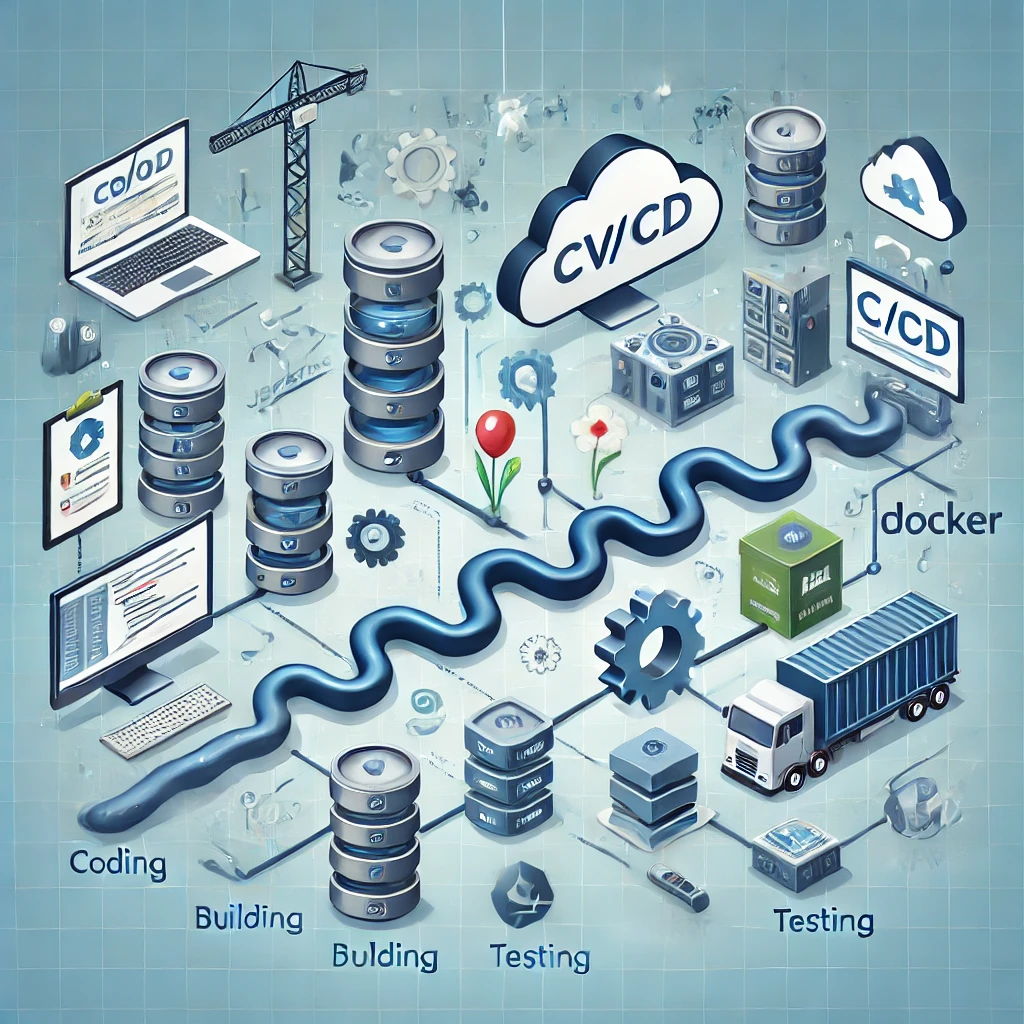What is DevOps? An Overview of Principles and Benefits
What is DevOps? A Complete Beginner's Guide
Understanding DevOps Principles :-
- At its core, DevOps is more than just a set of tools—it's a cultural shift that bridges the gap between development and operations teams. Historically, these teams operated in silos, resulting in slow development cycles and frequent deployment failures. DevOps fosters collaboration, communication, and shared responsibility throughout the entire software lifecycle. Key principles include Continuous Integration, Continuous Delivery (CI/CD), Infrastructure as Code (IaC), and proactive monitoring.
- Imagine DevOps as a well-synchronized team working toward a unified goal: faster and more reliable software releases. One of the pivotal aspects of DevOps is automation. By automating repetitive tasks, developers and operations engineers can dedicate their efforts to tackling more complex challenges. This automation not only streamlines processes but also minimizes human errors. The result? Enhanced efficiency, reduced time-to-market, and superior software quality.
For ApnaGuru :-
- This streamlined philosophy of DevOps aligns perfectly with our mission of delivering cutting-edge solutions. By adopting DevOps practices, organizations can achieve faster, more reliable, and efficient workflows, ensuring a better user experience.
Exploring CI/CD Pipelines :-
- CI/CD, or Continuous Integration and Continuous Delivery/Deployment, is a cornerstone of DevOps. CI focuses on automating the integration of code changes from multiple developers into a shared repository. This involves regular builds and automated testing to catch bugs early in the development process. CD extends this by automating the deployment of code to various environments, from development to staging to production. Imagine a conveyor belt moving code smoothly from one stage to the next, ensuring a consistent and efficient flow.
- The benefits of CI/CD are manifold. It allows for faster feedback loops, early detection of issues, and reduced risk associated with deploying new code. Teams can iterate quickly, releasing new features and updates frequently without compromising stability. This agility is essential in today's fast-paced software development landscape, where speed and adaptability are crucial for success. Implementing CI/CD requires careful planning and selection of the right tools, but the payoff in terms of efficiency and improved software quality is well worth the effort.
Key DevOps Tools: Jenkins and Docker :-
- Jenkins and Docker are two powerful tools that play a significant role in modern DevOps practices. Jenkins is an open-source automation server that can be used to automate a wide range of tasks, including building, testing, and deploying software. It supports a vast ecosystem of plugins, making it highly versatile and customizable. Think of Jenkins as the orchestrator of your CI/CD pipeline, automating every step of the process.
- Docker, on the other hand, is a containerization platform that packages applications and their dependencies into isolated containers. These containers can run consistently across different environments, making deployments much more reliable and predictable. Imagine packaging your application and all its required libraries into a self-contained unit that can be easily transported and deployed anywhere. This eliminates the "it works on my machine" problem and ensures consistency across different stages of the development process. The combination of Jenkins and Docker provides a powerful foundation for automated deployments.
Automating Deployments with Jenkins and Docker
Step-by-Step Deployment Automation Tutorial :-
- Automating deployments involves setting up a CI/CD pipeline that automatically builds, tests, and deploys your application whenever code changes are pushed to the repository. This typically involves using tools like Jenkins to orchestrate the process and Docker to containerize the application. The first step is to create a Dockerfile, which defines how your application should be built and packaged into a container image. Then, configure Jenkins to build the image, run automated tests, and push the image to a container registry (like Docker Hub).
- Next, you need to set up your deployment environment, which could be a cloud platform like AWS, Azure, or Google Cloud, or a on-premise server. You'll need to configure your deployment environment to pull the latest container image from the registry and start the application. Jenkins can automate this process by using plugins that interact with your chosen cloud platform or deployment tools. This creates a completely automated workflow: code changes trigger a build, tests are run, and a new container image is deployed to your target environment, all without manual intervention. This level of automation greatly reduces deployment time and the risk of errors.
Practical Example: Automating a Web Application Deployment:-
- Let's imagine a simple web application written in Python using Flask. We can create a Dockerfile that installs Python, Flask, and copies our application code into the container. Jenkins can then be configured to build this Docker image whenever changes are pushed to our Git repository. After a successful build, Jenkins can run automated tests (e.g., using pytest) to ensure the application is working correctly. If the tests pass, Jenkins can push the image to Docker Hub.
- Finally, our deployment environment (let's say an AWS EC2 instance) can be configured to pull the latest image from Docker Hub and automatically restart the application using Docker Compose or Kubernetes. This entire process is automated, ensuring that every code change is promptly tested and deployed to production, providing fast feedback cycles and a more reliable application. The efficiency gains and reduced risk are significant, showcasing the power of automated deployments.
Infrastructure as Code: Terraform vs. CloudFormation
Understanding Infrastructure as Code :-
- Infrastructure as Code (IaC) is a practice where infrastructure is managed and provisioned through code, rather than manual configuration. This allows for automation, version control, and repeatability in setting up and managing IT infrastructure. Tools like Terraform and CloudFormation allow you to define your infrastructure in a declarative manner, specifying the desired state of your resources (e.g., servers, networks, databases).
- The benefits of IaC are numerous. It eliminates manual configuration errors, improves consistency across environments, and enables faster deployment. You can easily replicate your infrastructure across different cloud providers or on-premise environments, ensuring consistency. Version control allows you to track changes to your infrastructure, making it easier to roll back to previous configurations if needed. This approach is essential for managing complex, dynamic environments, ensuring reliability and reducing operational overhead.
Terraform: Features and Practical Example :-
- Terraform, developed by HashiCorp, is a popular IaC tool that supports multiple cloud providers and infrastructure platforms. It uses a declarative configuration language (HCL) to define your infrastructure. You write a Terraform configuration file that describes the desired state, and Terraform manages the process of creating and updating the infrastructure to match that state. Terraform's state management is a key feature, keeping track of what resources have been provisioned and allowing for efficient updates and rollbacks.
- For example, you can use Terraform to define and create an EC2 instance on AWS. The configuration file would specify the instance type, AMI, security groups, and other parameters. Terraform would then automatically provision the instance, ensuring it meets your specifications. This reduces manual steps involved in provisioning and configuring an EC2 instance, reducing errors and saving time. The portability of Terraform configurations allows you to deploy the same infrastructure on different cloud providers by simply changing a few parameters in the configuration file.
CloudFormation: Features and Practical Example :-
- AWS CloudFormation is a service that allows you to model and set up AWS resources using JSON or YAML templates. Similar to Terraform, you define your infrastructure in a template and CloudFormation handles the provisioning and management. CloudFormation excels at managing AWS resources and integrates seamlessly with other AWS services. It provides features like change sets for reviewing changes before deployment and rollback capabilities for easy recovery from errors.
- You could use CloudFormation to create a stack of AWS resources, such as an EC2 instance, an S3 bucket, and an RDS database. The template would specify the configurations for each resource. CloudFormation would then create these resources, ensuring they are properly configured and interconnected. This automated approach significantly simplifies the process of creating complex AWS environments, ensuring consistency and reducing manual configuration errors. The tight integration with other AWS services makes it a powerful tool for managing AWS-centric infrastructures.
Head-to-Head Comparison: Terraform vs. CloudFormation :-
- Both Terraform and CloudFormation are powerful IaC tools. Terraform's advantage lies in its multi-cloud support, providing flexibility across different cloud providers and on-premise environments. CloudFormation, while deeply integrated with AWS, lacks this cross-platform capability. The choice between them often depends on your specific needs and environment. If you require consistent infrastructure across multiple providers, Terraform is the preferred choice. If your infrastructure is primarily based on AWS, CloudFormation offers a tightly integrated solution.
- In terms of ease of use, both have their own learning curves. Terraform's HCL is generally considered more intuitive by many users, while CloudFormation's YAML or JSON templates can become complex for large infrastructures. Ultimately, both tools offer significant benefits for managing infrastructure as code, promoting automation, consistency, and repeatability in managing IT resources. Choosing between them requires careful consideration of the specific needs of your project and organization.
Review
Kalpesh Shewale
I am grateful to have completed my Full Stack Development with AI course at Apnaguru. The faculty's support and interactive classes helped me discover my potential and shape a positive future. Their guidance led to my successful placement, and I highly recommend this institute.
Kalpesh Shewale
I am grateful to have completed the Full Stack Development with AI course at Apnaguru. The faculty's dedicated support and hands-on approach during the classes enabled me to unlock my potential and shape a promising future. Their guidance helped me secure a placement with a good package. I highly recommend this course, and for those interested, I also suggest doing the offline version at the center for an enhanced learning experience.

Raveesh Rajput
Completing the Full Stack Development with AI course at Apnaguru was a game-changer for me. I secured an internship through this course, which gave me invaluable hands-on experience. I strongly recommend this course to anyone looking to break into the tech industry. For the best experience, I suggest attending the offline sessions at the center, where the interactive learning environment really enhances the overall experience.

swapnil shinde
Apnaguru’s Full Stack Development with AI course provided me with more than just knowledge—it opened doors to an internship that gave me real-world, hands-on experience. If you're serious about a career in tech, this course is a must. I highly recommend attending the offline sessions for the most immersive and interactive learning experience!
Kalpana Waghmare
I recently completed the Full Stack Developer with AI course on ApnaGuru, and I couldn’t be more impressed! The structure of the course, with well-organized topics and self-assessment MCQs after each section, really helped reinforce my learning. The assignments were particularly valuable, allowing me to apply what I learned in a practical way. Overall, it’s an excellent program that effectively combines full-stack development and AI concepts. Highly recommended for anyone looking to enhance their skills!
Completing the Full Stack Development with AI course at Apnaguru was a pivotal moment in my career. It not only deepened my understanding of cutting-edge technologies but also directly led to an internship that provided practical, real-world experience. If you're aiming to enter the tech field, this course is an excellent stepping stone. I especially recommend attending the in-person sessions at the center, where the dynamic, hands-on learning approach truly maximizes the benefits of the program.

Mahesh Bhosle
I completed the Full Stack Development course at Apnaguru, and it was a valuable experience. The focus on live assignments and projects gave me real-world insights, helping me apply my skills in a professional setting. The interactive live sessions, mock interviews, and question banks were excellent for job preparation. Apnaguru’s company-like environment also helped me get accustomed to real work dynamics. Overall, this course equipped me with the skills and confidence needed for a career in full-stack development. I highly recommend it to anyone seeking hands-on learning and industry relevance.
I recently completed the Full Stack course at ApnaGuru, and I’m genuinely impressed! The curriculum is well-structured, covering both front-end and back-end technologies comprehensively. The instructors are knowledgeable and provide hands-on experience through practical projects. The supportive community and resources available made learning enjoyable and engaging. Overall, it’s a great choice for anyone looking to kickstart a career in web development. Highly recommend!

Adarsh Ovhal
I recently participated in the Full Stack Development With AI Course program, and it has been incredibly beneficial. The guidance I received was tailored to my individual needs, thanks to their advanced use of AI tools. The Trainers were knowledgeable and supportive, helping me explore various educational and career paths. The resources and workshops provided were practical and insightful, making my decision-making process much clearer. Overall, I highly recommend this program to any student looking for IT Field and personalized career guidance!
Shirish Panchal
I’m currently pursuing the Full Stack Developer with AI course at ApnaGuru Training Center, and I'm impressed with what I've experienced so far. The curriculum is well-structured, covering key concepts in both front-end and back-end development, along with AI fundamentals. The instructors are knowledgeable and supportive, which makes it easy to engage and ask questions. I particularly appreciate the hands-on projects that help reinforce what I’m learning. While I’m still in the process of completing the course, I feel that I'm building a strong foundation for my future in tech. I would recommend ApnaGuru to anyone looking to explore full stack development with AI!
Apnaguru Training Center stands out as a top-notch institute for IT education. They provide a wide array of courses, including Full Stack Development, Java Full Stack, Python, Automation Testing, DevOps, and MERN/MEAN Stack, all designed to meet the demands of the modern tech industry.

Mahesh Bhosle
Apnaguru Training Center is a fantastic place for IT education! They offer a variety of courses, including Full Stack Development, Java Full Stack, and Python, all taught by knowledgeable instructors who are committed to student success. The curriculum is up-to-date and includes hands-on projects that enhance learning.
dandewar srikanth
I had an excellent experience with the full-stack web development program at APNAGURU. The instructor had in-depth knowledge of both frontend and backend technologies, which made the concepts easy to grasp. From working on HTML, CSS, JavaScript, and React for the frontend to Node.js and MongoDB for the backend, the learning curve was very smooth.
